Streamer Propagation and Breakdown in a Very Small Point-Insulating Plate Gap in Mineral Oil and Ester Liquids at Positive Lightning Impulse Voltage
Abstract
:1. Introduction
2. Measurement Setup
- 24 h of drying in a vacuum at a temperature of 105 °C,
- impregnation with the given liquid in a vacuum at a temperature of 85 °C for 24 h, and
- lying in the vacuum at ambient temperature for 24 h.
3. Measurement Assumptions
- V0 is the location parameter for which F(V0) = 0, meaning the threshold value of voltage below, in which discharge initiation in a given electrode configuration does not occur (expressed in kV);
- Vm is the scale parameter for which F(Vm) = 1 − e−1 ≈ 0.632, representing the value of voltage below, in which 63.2% of the analyzed population of inception voltages is included (expressed in kV);
- k is the shape parameter, a measure of the dispersion of the data;
- Vi is the random variable (inception voltages measured in kV).
4. Results of the Measurements
5. Conclusions
- In the point-insulating plate electrode systems investigated in these studies, the variety of phenomena which are possible to observe at a given voltage level is greater than that in classically applied electrode systems, including bare electrodes. The unambiguous inference is therefore much more difficult in the considered case.
- The measurements performed demonstrated that, in the case of the propagation of already-initiated streamers in the tested point-insulating plate electrode system, ester liquids, as in the case of the systems with bare electrodes, demonstrate a lower resistance against the appearance of fast and energetic streamers than mineral oil. Although the inception voltage and the threshold value of the testing voltage for the appearance of fast streamers are similar, for both of the liquids tested, the differences in the results obtained are clearly indicated. The number of fast streamers observed for the voltages between 1.4 and 1.8 of Vi was always much higher in the case of synthetic and natural ester than that of mineral oil.
- The ability to form a breakdown channel was also higher in the case of the ester liquids, where breakdown occurred almost always, only at the voltage level equal to 1.6 Vi. For mineral oil, for this voltage level, the different types of streamer propagation modes were registered from slow propagating streamers, through fast streamers that did not lead to the breakdown, up to breakdown similar to this observed in the esters. Intensification of the differences between the liquids tested at testing voltages equal to 1.8 Vi definitely strengthened the above-formed conclusion.
- Limiting the comparison only to the esters tested, it was found that synthetic ester behaved a little better under lightning stresses. Both for 1.4 and 1.6 Vi, the number of fast streamers registered and the number of breakdowns occurring at the 20 lightning impulses supplied were lower than the corresponding numbers concerning natural ester. However, comparing the oscillograms collected, there were no obvious differences between the esters under consideration.
- Relating the observations quoted to the theory of propagation of the streamers in liquid dielectrics, it may be supposed that both esters in small point-insulating plate electrode systems are similarly more susceptible on the appearance of such types of the streamers, which propagate as a result of liquid phase ionization (3rd or 4th propagation mode). The channels of such streamers seem to be more energetic than channels of the streamers propagating slowly (2nd mode). In turn, if the breakdown occurs in the gap that is filled with one of the esters, it is characterized by a more intense impact on solid insulation that may be damaged easier.
Acknowledgments
Author Contributions
Conflicts of Interest
References
- McShane, C.P. Vegetable-oil-based dielectric coolants. IEEE Ind. Appl. Mag. 2002, 2, 34–41. [Google Scholar] [CrossRef]
- Borsi, H.; Gockenbach, E. Properties of ester liquid Midel 7131 as an alternative liquid to mineral oil for transformers. IEEE Int. Conf. Dielectr. Liq. 2005, 377–380. [Google Scholar] [CrossRef]
- Gockenbach, E.; Borsi, H. Natural and synthetic ester liquids as alternative to mineral oil for power transformers. IEEE Conf. Electr. Insul. Dielectr. Phenom. 2008, 521–524. [Google Scholar] [CrossRef]
- Perrier, C.; Beroual, A. Experimental investigations on insulating liquids for power transformers: Mineral, ester and silicone oils. IEEE Elect. Insul. Mag. 2009, 25, 6–13. [Google Scholar] [CrossRef]
- CIGRE brochure 436. Experiences in Service with New Insulating Liquids; International Council on Large Electric Systems: Paris, France, 2011. [Google Scholar]
- Lashbrook, M.; Kuhn, M. The use of ester transformer fluids for increased fire safety and reduced costs. CIGRE Tech. Progr. 2012, A2–A210. [Google Scholar]
- Fernández, I.; Ortiz, A.; Delgado, F.; Renedo, C.; Pérez, S. Comparative evaluation of alternative fluids for power transformers. Electr. Power Syst. Res. 2013, 98, 58–69. [Google Scholar] [CrossRef]
- Liao, R.J.; Hao, J.; Chen, G.; Ma, Z.Q.; Yang, L.J. A comparative study of physicochemical, dielectric and thermal properties of pressboard insulation impregnated with natural ester and mineral oil. IEEE Trans. Dielectr. Electr. Insul. 2011, 18, 1626–1637. [Google Scholar] [CrossRef]
- Martins, M.A.G.; Gomes, A.R. Comparative study of the thermal degradation of synthetic and natural esters and mineral oil: effect of oil type in the thermal degradation of insulating Kraft paper. IEEE Electr. Insul. Mag. 2012, 28, 22–28. [Google Scholar] [CrossRef]
- Talhi, M.; Fofana, I.; Flazi, S. Comparative study of the electrostatic charging tendency between synthetic ester and mineral oil. IEEE Trans. Dielectr. Electr. Insul. 2013, 20, 1598–1606. [Google Scholar] [CrossRef]
- Loiselle, L.; Fofana, I.; Sabau, J.; Magdaleno-Adame, S.; Olivares-Galvan, J.C. Comparative studies of the stability of various fluids under electrical discharge and thermal stresses. IEEE Trans. Dielectr. Electr. Insul. 2015, 22, 2491–2499. [Google Scholar] [CrossRef]
- Bandara, K.; Ekanayake, C.; Saha, T.; Ma, H. Performance of natural ester as a transformer oil in moisture-rich environments. Energies 2016, 9, 258. [Google Scholar] [CrossRef]
- Duy, C.T.; Denat, A.; Lesaint, O.; Bonifaci, N. Streamer propagation and breakdown in natural ester at high voltage. IEEE Trans. Dielectr. Electr. Insul. 2009, 16, 1582–1594. [Google Scholar] [CrossRef]
- Dang, V-H.; Beroual, A.; Perrier, C. Comparative study of streamer phenomena in mineral, synthetic and natural ester oils under lightning impulse voltage. Int. Conf. High Volt. Eng. Appl. 2010, 560–563. [Google Scholar] [CrossRef]
- Liu, Q.; Wang, Z.D. Streamer characteristic and breakdown in synthetic and natural ester transformer liquids under standard lightning impulse. IEEE Trans. Dielectr. Electr. Insul. 2011, 18, 285–294. [Google Scholar] [CrossRef]
- Liu, Q.; Wang, Z.D. Secondary reverse streamer observed in an ester insulating liquid under negative impulse voltage. J. Phys. D: Appl. Phys. 2011, 44. [Google Scholar] [CrossRef]
- Rozga, P. Streamer propagation in small gaps of synthetic ester and mineral oil under lightning impulse. IEEE Trans. Dielectr. Electr. Insul. 2015, 22, 2754–2762. [Google Scholar] [CrossRef]
- Devins, J.C.; Rzad, S.J.; Schwabe, R.J. Breakdown and prebreakdown phenomena in liquids. J. Appl. Phys. 1981, 52, 4531–4545. [Google Scholar] [CrossRef]
- Beroual, A. Electronic and gaseous processes in prebreakdown phenomena of dielectric liquids. J. Appl. Phys. 1993, 73, 4528–4532. [Google Scholar] [CrossRef]
- Tobazoen, R. Prebreakdown phenomena in dielectric liquids. IEEE Trans. Dielectr. Electr. Insul. 1996, 1, 1132–1147. [Google Scholar] [CrossRef]
- Lesaint, O.; Massala, G. Positive streamer propagation in large oil gaps: Experimental characterization of propagation mode. IEEE Trans. Dielectr. Electr. Insul. 1998, 5, 360–370. [Google Scholar] [CrossRef]
- Galczak, J. Electrical discharges in mineral oil developing from insulated transformer wire to plane. Arch. Electr. Eng. 2004, 73, 353–367. [Google Scholar]
- Lundgaard, L.; Linhjell, D.; Berg, G.; Sigmond, S. Propagation of positive and negative streamers in oil with and without pressboard interfaces. IEEE Trans. Dielectr. Electr. Insul. 1998, 5, 388–395. [Google Scholar] [CrossRef]
- Rozga, P. The influence of paper insulation on the prebreakdown phenomena in mineral oil under lightning impulse. IEEE Trans. Dielectr. Electr. Insul. 2011, 11, 720–727. [Google Scholar] [CrossRef]
- IEC 60296 Standard: Fluids for Electrotechnical Applications—Unused Mineral Insulating Oils for Transformers and Switchgears; International Electrotechnical Commission: Geneva, Switzerland, 2012.
- IEC 61099 Standard: Insulating Liquids – Specifications for Unused Synthetic Organic Esters for Electrical Purposes; International Electrotechnical Commission: Geneva, Switzerland, 2011.
- IEC 62770 Standard: Fluids for Electrotechnical Applications - Unused Natural Esters for Transformers and Similar Electrical Equipment; International Electrotechnical Commission: Geneva, Switzerland, 2014.
- Rozga, P.; Stanek, M.; Cieslinski, D. Comparison of properties of electrical discharges developing in natural and synthetic ester at inception voltage. 2013 IEEE Annual Report Conf. Electr. Insul. Diel. Phenom. 2013, 891–894. [Google Scholar] [CrossRef]
- Mosinski, F.; Wodzinski, J.; Sikorski, L.; Ziencikiewicz, J. Electrical strength of paper-oil insulation subjected to composite voltages. IEEE Trans. Dielectr. Electr. Insul. 1994, 1, 615–623. [Google Scholar] [CrossRef]
- Mosinski, F.; Piotrowski, T. New statistical methods for evaluation of DGA data. IEEE Trans. Dielectr. Electr. Insul. 2003, 10, 260–265. [Google Scholar] [CrossRef]
- Piotrowski, T. Probability distribution of gases dissolved in oil of failed power transformers. Int. Conf. High Volt. Eng. Applic. 2014, 1–4. [Google Scholar] [CrossRef]
- IEC 60243–1 Standard: Electric Strength of Insulating Materials - Test Methods - Part 1: Tests at Power Frequencies; International Electrotechnical Commission: Geneva, Switzerland, 2013.
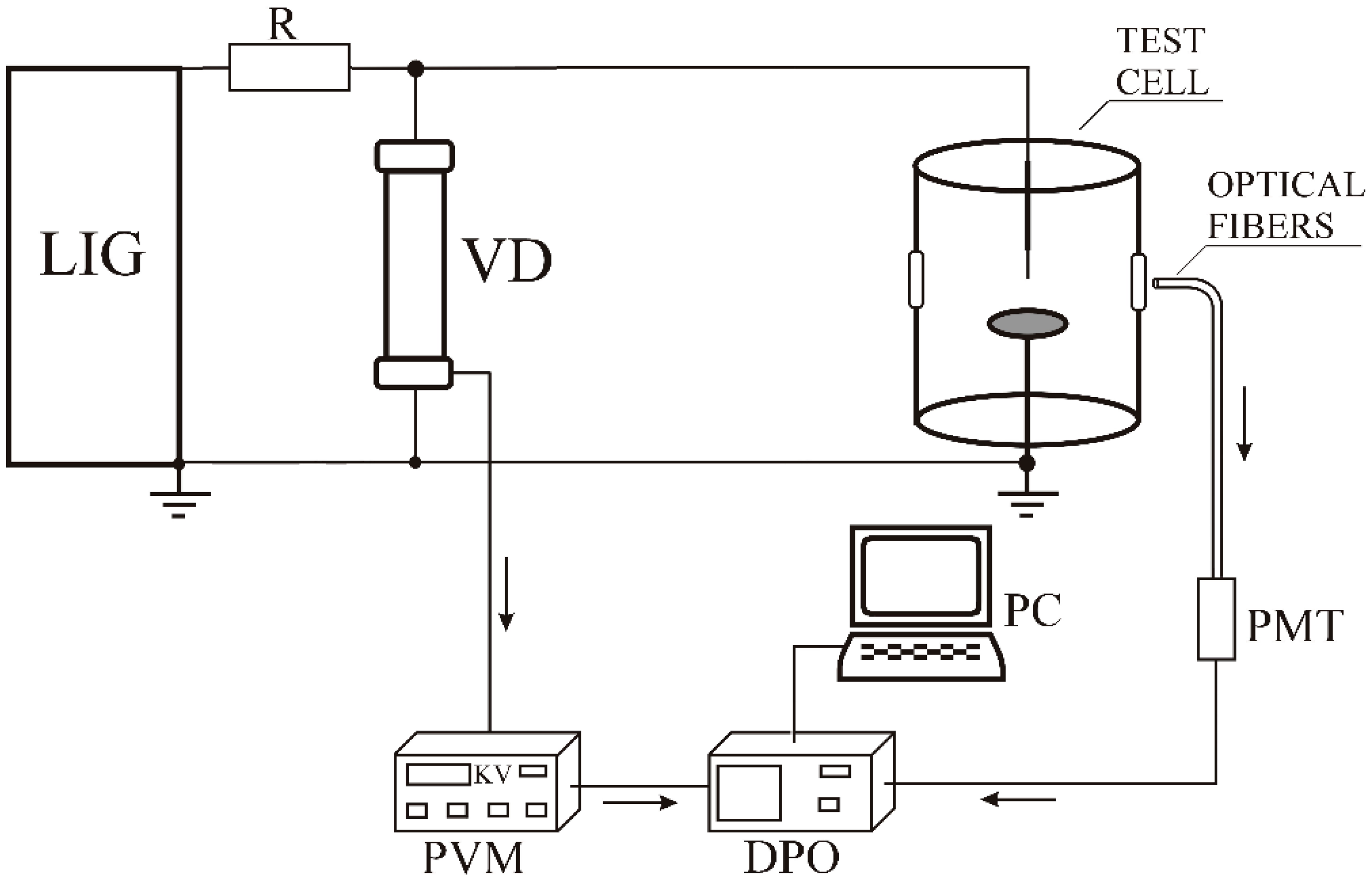


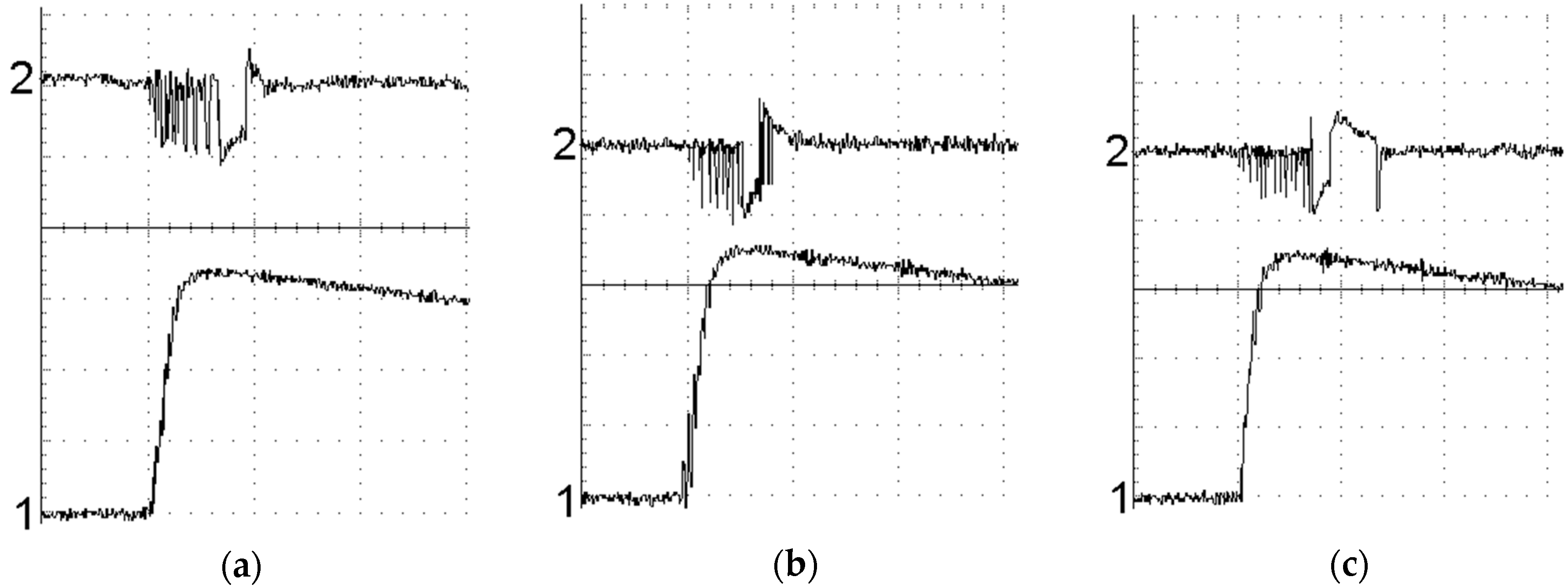


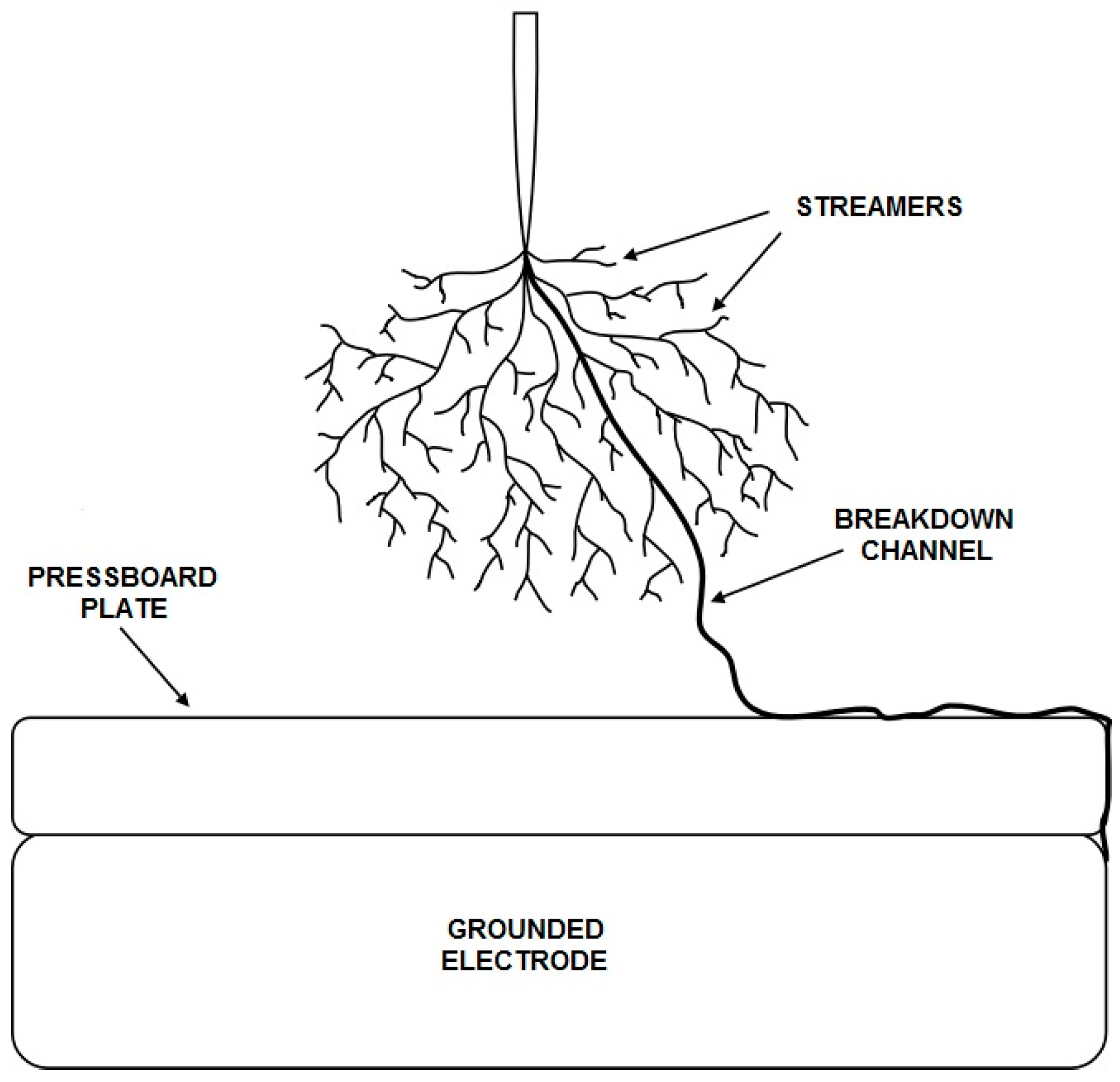
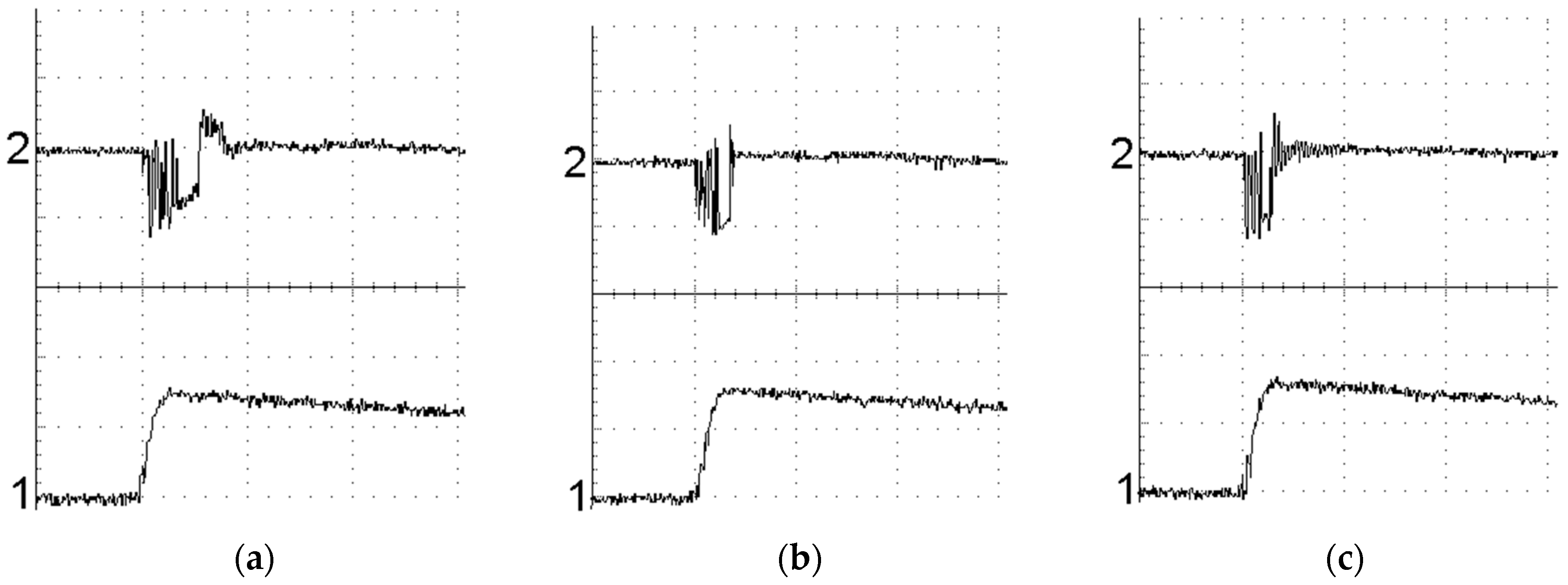
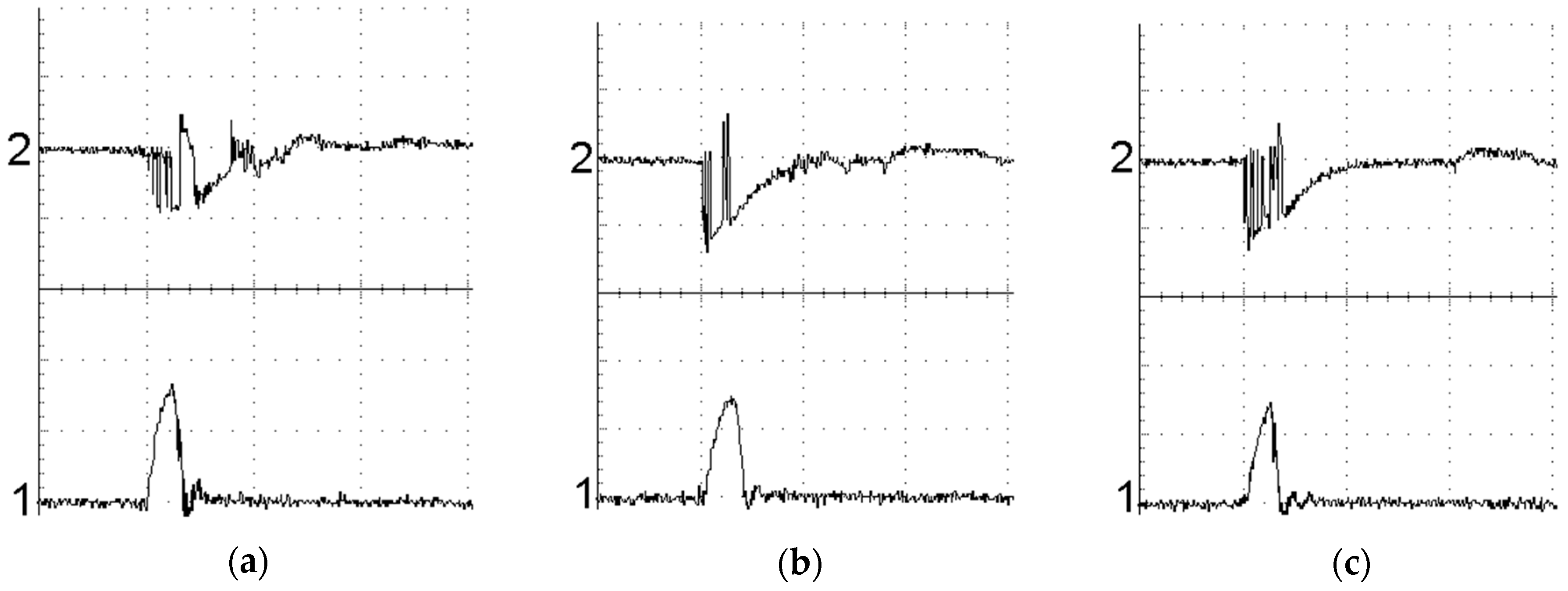
| Parameters | Synthetic Ester | Natural Ester | Mineral Oil |
|---|---|---|---|
| AC breakdown voltage—mean value [kV] | 64 | 67 | 66 |
| Dielectric dissipation factor at 90 °C and 50 Hz | 0.0108 | 0.0446 | 0.004 |
| Moisture content [ppm] | 129 | 102 | 12 |
| Type of Liquid | V0 [kV] | Vm [kV] | k | VMed [kV] |
|---|---|---|---|---|
| Synthetic ester | 49.9 | 55.8 | 0.9 | 53.7 |
| Natural ester | 49.3 | 54.4 | 1.6 | 53.4 |
| Mineral oil | 43.2 | 55.3 | 4.2 | 54.3 |
| Inception Voltage Multiplier | Liquid Type | |||||
|---|---|---|---|---|---|---|
| Synthetic Ester | Natural Ester | Mineral Oil | ||||
| Number of Fast Streamers per 20 LI Supplied | Number of Breakdowns per 20 LI Supplied | Number of Fast Streamers per 20 LI Supplied | Number of Breakdowns per 20 LI Supplied | Number of Fast Streamers per 20 LI Supplied | Number of Breakdowns per 20 LI Supplied | |
| 1.4 Vi | 13 | 7 | 14 | 9 | 11 | 0 |
| 1.6 Vi | 18 | 14 | 20 | 18 | 14 | 6 |
| 1.8 Vi | 20 | 20 | 20 | 20 | 20 | 13 |
© 2016 by the author; licensee MDPI, Basel, Switzerland. This article is an open access article distributed under the terms and conditions of the Creative Commons Attribution (CC-BY) license (http://creativecommons.org/licenses/by/4.0/).
Share and Cite
Rozga, P. Streamer Propagation and Breakdown in a Very Small Point-Insulating Plate Gap in Mineral Oil and Ester Liquids at Positive Lightning Impulse Voltage. Energies 2016, 9, 467. https://doi.org/10.3390/en9060467
Rozga P. Streamer Propagation and Breakdown in a Very Small Point-Insulating Plate Gap in Mineral Oil and Ester Liquids at Positive Lightning Impulse Voltage. Energies. 2016; 9(6):467. https://doi.org/10.3390/en9060467
Chicago/Turabian StyleRozga, Pawel. 2016. "Streamer Propagation and Breakdown in a Very Small Point-Insulating Plate Gap in Mineral Oil and Ester Liquids at Positive Lightning Impulse Voltage" Energies 9, no. 6: 467. https://doi.org/10.3390/en9060467
APA StyleRozga, P. (2016). Streamer Propagation and Breakdown in a Very Small Point-Insulating Plate Gap in Mineral Oil and Ester Liquids at Positive Lightning Impulse Voltage. Energies, 9(6), 467. https://doi.org/10.3390/en9060467






